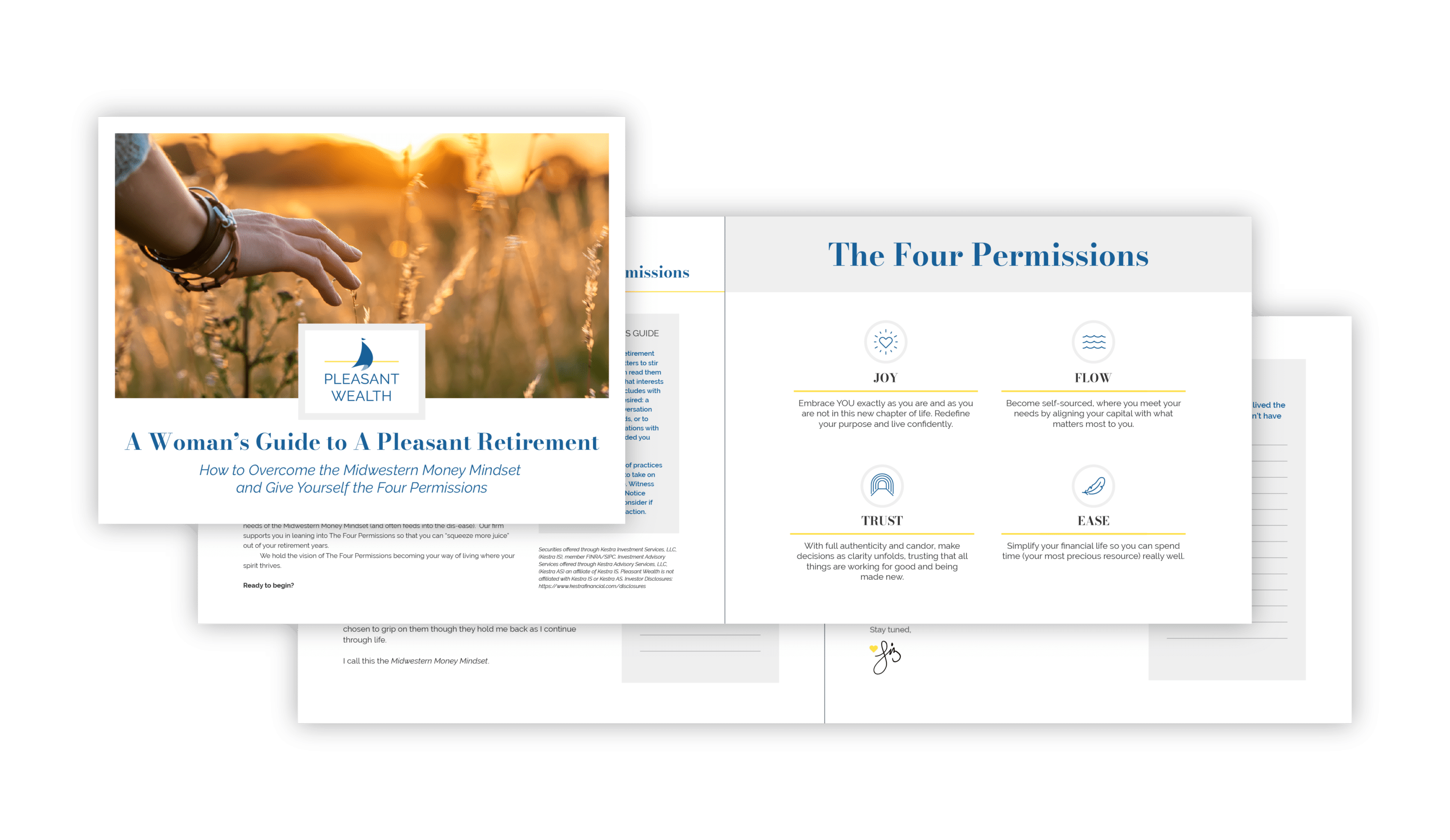Don’t go without downloading our free retirement guide!
A Woman’s Guide to a Pleasant Retirement
How to Overcome the Midwestern Money Mindset and Give Yourself the Four Permissions

Check the background of this firm on FINRA’s BrokerCheck →
As a rule of thumb, I like to push back on retirement rules of thumb (or whatever the plural of ‘rule of thumb’ is).
Withdraw this percentage of your investments. Take Social Security at this age. Spend this portion of your working years’ expenses.
Don’t get me wrong, guidelines like these can be helpful, especially for those who don’t know where to start. But they can also be just as limiting as they are useful.
As part of our coaching approach, Pleasant Wealth has been inviting clients to notice the cycles of nature to guide life and financial decisions. It allows clients to align their financial intentions with the natural sunlight and weather patterns. Before you cast this off as an idea, hear me out.
Think about it. What is your life rhythm patterned to? A corporate quarterly reporting timeframe? A school calendar? Are those calendars even relevant to your next 5-10 years? Wouldn’t it make sense as you exit your career to start mirroring a natural rhythm that aligns with the blooms, birds, and landscape? It’s a cue to take specific action. You don’t have to know when to hibernate or plant, or play, or shed what’s decaying in life. Nature is cueing you to do that.
So, how does that relate to money? We are nearing planting season in Ohio. Before a gardener begins to plant, they first take stock of the resources & measurements for gardening. It’s the preparation before we start planting.
Now, before we retire, we need to account for our resources to ensure we have a solid plan. That’s where the idea of approximations comes into play. If you search the internet for how much to spend in retirement, you will likely find this answer near the top of the results: 80%. That is, once you retire, you’ll spend 80% of what you did before you retired.
Now, I’m not here to argue that this figure isn’t accurate for some people. In fact, I know some people who are incredibly frugal in their retirement years. But I’m here to push back, shift the focus, and view retirement spending from a different perspective.
Before we begin shifting our mindset, it’s helpful to explore what can make this particular rule of thumb problematic.
Our lives can change drastically when we reach retirement. The anchor of our adult lives, the job at which we spent almost a quarter (or maybe, more than a quarter) of our weekly time, is gone. We may replace that job with a host of new hobbies and activities, or maybe, we’ll just spend more time at home. Either way, our lives will look much different. And our budgets might too.
When we talk about retirement spending as a product of our pre-retirement spending, we can really limit our ability to envision a different, new life in retirement. We’re not just crossing out a few items that we used to spend money on. And we’re not going to cut 20% across the board in every category. Our retirement budget may have all sorts of new categories and expenses. So paring down to 80% of something completely different may not be a realistic or helpful way to think about how we spend in retirement.
We’ve talked about the Bag Lady Syndrome before. For the uninitiated, Bag Lady Syndrome is this idea that, as someone with ample financial resources, you’ll run out of money in retirement and become homeless, living out of shopping bags. It’s realistic, but it can totally change how we spend (or don’t spend) money.
And this idea of framing retirement spending as a percentage of pre-retirement spending can contribute to that type of Bag Lady mindset in two ways. First, you’re limiting your focus solely to spending, not to how much you can realistically afford to spend. In reality, you may have the ability to spend far beyond 80% of pre-retirement expenses. Secondly, the notion that you should, or will, spend less than you did before retiring gives off this feeling that you need to cut back or be more mindful of how you’re spending.
Taking the previous point a step further, what you can afford may not be what you’re envisioning for retirement. By building this rule of thumb in as an assumption into your retirement planning, you may fail to see the forest for the trees. In doing that, you may not fully consider possibilities that you’d enjoy having or doing, or you may not have a plan suited to meet you needs and wants. The result is a limitation on your vision, your resources, or both.
Instead of limiting our perspective by guidelines for retirement income, we can shift our mindset and think about retirement expenses and income in ways that expand our joy. Let’s explore three specific ways to accomplish this.
What is it that you specifically want out of your retirement? Do any goals come to mind? Do any of the following resonate?
Okay, the last one is admittedly a bit specific, but I do know someone who leaned into making maple syrup as a hobby in retirement. It quickly transitioned from hobby to business. But it illustrates that you can choose to create a retirement that you want.
For all of these ideas I just listed, there are very measurable aspects to them that tie back to a financial plan. International trips have a general ballpark you’d likely spend. Buying or building a vacation home will have a tangible price tag. Giving your five grandchildren a certain amount of money is specific. And starting a hobby like making maple syrup will have involve specific costs for equipment to launch the hobby.
The point here is that if you can become specific about your big picture retirement goals, that specificity is something you can leverage in your financial plan.
It’s easy to fall into the trap of being overly optimistic when building out long-term plans.
Just look at any government entity’s forecasted budget compared to the final numbers. They don’t typically align. And it makes sense. We want to present the potential of a rosy outcome that makes people buy in, but the components can be far more challenging to execute in reality.
So let me reflect this back to you about your retirement. Are the numbers something you want to believe will happen? Or are they truly achievable goals?
We’ve covered this above, but if you’re unrealistic about your expenses, you could run into two problems. You may cut corners to see them through, perhaps at the expense of your happiness. Or you may have a financial plan with some assumptions that aren’t accurate, presenting possibilities that you may need to readjust or be less financially secure than you’d like.
There are a lot of data points that go into a financial plan, and working with a financial planner should hopefully help you be more realistic about your expenses. But you should still ask this tricky question now. It’s easier to make adjustments the more time you have.
“You can’t buy this because I don’t want you to buy it.”
That’s not usually something you hear spouses say to each other. But that’s essentially what people are saying when they tell themselves or someone else that they can’t afford something, even when they don’t have a good grasp on how much they can afford to spend.
Unfortunately, this dynamic often plays out between spouses. One spouse is in charge of the money and directs how much the other spouse can spend. Since one spouse has more financial information, they hold the control to make these decisions. It’s possible that maybe the couple can afford to buy new bikes, a set of kayaks, or a few new outfits. What’s stopping them isn’t money, but a lack of knowledge.
Don’t get me wrong, this can be an especially challenging hurdle to overcome since it’s ingrained in the foundation of the relationship. But sometimes, this is a situation that plays out in our own heads, too. We can’t afford something because we don’t think we can afford it. But we don’t even know what we can and can’t afford.
By understanding your ability to spend—that is, taking account of your resources—you may be shocked at how much your focus expands and the possibilities that open up to you.
At the end of your retirement, you may wind up spending 80% of what you spent during your working years. But will that 80% be part of a life of limitations and telling yourself you can’t afford things? Or will your retirement spending, even if it is less, be part of a life of expanded focus and joy?
By examining the three areas we outlined—getting specific about your retirement goals, being realistic about your expenses, and understanding your ability to spend—I hope you can gain more clarity about what lies ahead for you.
At Pleasant Wealth, we’re committed to helping our clients feel good about their money. One way we tangibly achieve this is through regular coaching sessions to help clients overcome some of their misconceptions about money. If you’d like to learn more about becoming a client and feeling good about your money, you can schedule an intro call with our team.

Clinton Miller, CFP®, is an investment advisor & financial planner with an educational background in mathematics. He enjoys making tax planning relevant for clients so they can make confident money decisions.
He and his wife Aubrey are based in Canton, OH & have two sons. In his spare time, he enjoys fishing, chainsaw repair, & mucking around in the woods.